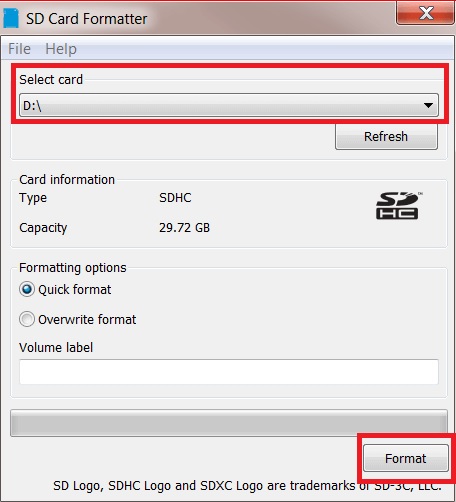

- #SD MEMORY CARD FORMATTER LINUX FOR RASPBERRY PI 3 INSTALL#
- #SD MEMORY CARD FORMATTER LINUX FOR RASPBERRY PI 3 CODE#
- #SD MEMORY CARD FORMATTER LINUX FOR RASPBERRY PI 3 PC#
One can not be substituted for the other.įinally, the RAM Disk is a trick of the operating system that pretends that some of the available RAM is actually a storage disk.
#SD MEMORY CARD FORMATTER LINUX FOR RASPBERRY PI 3 CODE#
So although they both do the same job (SSD and RAM store code and data, gas cookers and microwaves cook food and warm up meals) they do this job in completely different and incompatible ways. SATA and USB connections are kept separately. The Rapsberry Pi CPU has a special connection for the RAM and nothing but Dynamic RAM can connect there. In my analogy the Dynamic RAM is the microwave oven and the high speed memory bus is the electricity mains supply.
#SD MEMORY CARD FORMATTER LINUX FOR RASPBERRY PI 3 PC#
An Operating System is the set of basic programs and utilities that allow your computer torun examples include Windows on a PC or OSX on a Mac.
#SD MEMORY CARD FORMATTER LINUX FOR RASPBERRY PI 3 INSTALL#
This memory bus goes directly into the heart of the CPU chip. Preparing your SD card for the Raspberry Pi In order to use your Raspberry Pi, you will need to install an Operating System (OS) onto an SDcard. Dynamic RAM chips follow a completely different protocol from Flash Memory chips and they connect to a Dynamic Memory Controller, who in turn, connects to a very high speed memory bus. If the power goes off then this refresh stops and their data are lost for ever.

This happens several hundreds or thousands of times per second and it is transparent to the user. They store data for a very short time, which makes it necessary to take them off-line (disconnect these chips from the rest of the circuits) to refresh their stored data. Dynamic RAM (also known as DDR SDRAM, etc). More than 32GB will have exFAT filesystem, so before installing anything on that SD card format. The typical RAM chips are known as DRAM, i.e. 16GB or 32Gb is fine, if you can afford 32 GB then go for it. In my analogy, the SSD is the gas cooking oven and the SATA bus is the gas supply to the house. This chip is connected to a SATA disk interface and follows the SATA protocol. They also need a special controller chip to talk to them. This means they can retain their data even without power. The SSD chips are Flash Memory and have a non-volatile storage ability, similar to the USB thumb disks. What can I do with it raspbian sd-card pi-zero Share Improve this question Follow edited at 9:37 Greenonline 2,720 4 22 35 asked at 7:40 Pras4 109 1 3 2 You can try using win32 disk imager (PC) or dd (Mac & Linux) to burn the image to your card. I tried to simplify the information that follows, so for anyone reading this with deeper understanding, please bear in mind this is only a very high level summary: They are so different, that the best analogy I can offer is like comparing a gas cooking oven to a microwave. It is not possible to replace one for the other. The memory chips on the SSD are very much different than normal RAM.

I think the confusion comes from the fact that SSD (Solid State Disk) is using memory chips to store the data. The memory for the Raspberry Pi is fixed on the board and there is no interface to extend it or replace it.


 0 kommentar(er)
0 kommentar(er)
